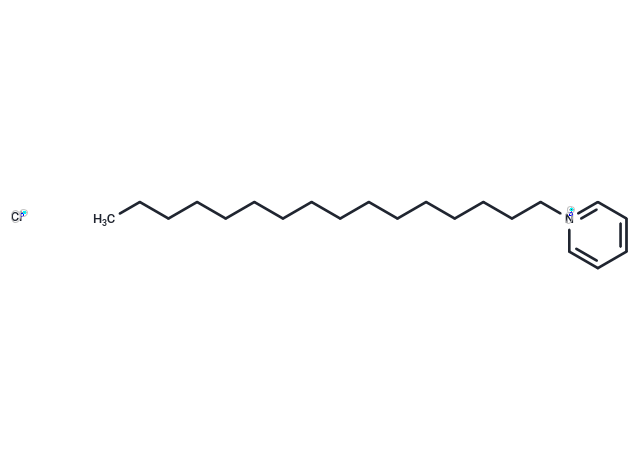Shopping Cart
- Remove All
 Your shopping cart is currently empty
Your shopping cart is currently empty


| Pack Size | Price | Availability | Quantity |
|---|---|---|---|
| 1 g | $30 | In Stock | |
| 1 mL x 10 mM (in DMSO) | $29 | In Stock |
| Description | Cetylpyridinium Chloride (Hexadecylpyridinium Chloride) is a cationic quaternary ammonium compound used as oropharyngeal antiseptic. |
| Targets&IC50 | HBV capsid assembly:2.5 μM (IC50) |
| In vitro | Cetylpyridinium chloride (CPC) as active ingredient of antiseptic oral mouthrinses has a broad antimicrobial spectrum with a rapid bactericidal effect on gram-positive pathogens and a fungicide effect on yeasts in particular. Application of CPC at a concentration of 0.05% as a mouthrinse results in an immediate reduction in bacterial counts of 2.0 to 2.5 log steps (which is adequate to > 99%). This reverts to about 1 log step (= 90%) 1 h after application. The ability of CPC to inhibit plaque and thereby reduce gingivitis is assured. In comparison to chlorhexidine, CPC has a lower residual effect, and as a result a lesser effect against plaque and gingivitis. The efficacy of CPC against oropharyngeal candidiasis is assured. CPC mouthrinses can significantly reduce infectious aerosols in dental practice, thereby protecting both staff and the patient. The balance of intra-oral bacterial flora is not disturbed even in the case of relatively long-term use of CPC (up to six weeks). [1] |
| In vivo | Cetylpyridinium chloride increases the risk of severe allergic reactions, such as swelling of the mouth, face, lips or tongue, labored breathing, rashes, and hives. Ingesting high concentrations of cetylpyridinium chloride can lead to lung damage. Cetylpyridinium chloride is toxic if swallowed or inhaled. [2] |
| Alias | Cetamium, Pristacin, Hexadecylpyridinium Chloride |
| Molecular Weight | 339.99 |
| Formula | C21H38N·Cl |
| Cas No. | 123-03-5 |
| Storage | store under nitrogen | Powder: -20°C for 3 years | In solvent: -80°C for 1 year | Shipping with blue ice. | |||||||||||||||||||||||||||||||||||
| Solubility Information | H2O: 62 mg/mL (182.4 mM) Ethanol: 63 mg/mL (185.3 mM) DMSO: 45 mg/mL (132.36 mM), Sonication is recommended. | |||||||||||||||||||||||||||||||||||
Solution Preparation Table | ||||||||||||||||||||||||||||||||||||
DMSO/H2O/Ethanol
| ||||||||||||||||||||||||||||||||||||

Copyright © 2015-2024 TargetMol Chemicals Inc. All Rights Reserved.